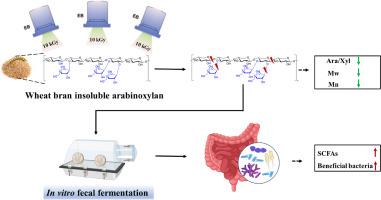电子束辐照解锁麦麸阿拉伯木聚糖的益生元潜力:结构修饰和肠道微生物群调节
IF 11
1区 农林科学
Q1 CHEMISTRY, APPLIED
引用次数: 0
摘要
小麦麸皮阿拉伯木聚糖(WBAX)是麦麸中的一种主要膳食纤维,由于其溶解度差和结构刚性,其生理功能有限。本文研究了0、5、10和15 kGy的电子束辐照(EBI)对不溶性WBAX (WIAX)的结构、理化和发酵特性的影响。通过分子量分析、XRD、FTIR、SEM、BET和热重表征,EBI诱导了剂量依赖性解聚、糖苷键裂解和表面改变。中等剂量(5和10 kGy)显著改善了溶解度、水合性能、脂质结合能力以及亚硝酸盐、胆盐、胆固醇和葡萄糖的吸附。在10 kGy时观察到最明显的增强,而15 kGy会导致过度的结构降解和功能性能下降。体外粪便发酵进一步证明,10 kGy辐照WIAX能促进细菌生长,加速碳水化合物利用,显著提高抗氧化活性和短链脂肪酸(SCFAs)的产生。微生物群落分析显示,EBI处理的WIAX,特别是在10 kGy时,丰富了有益的属,如Limosilactobacillus和Lactobacillus,降低了Proteobacteria的丰度,表明提高了益生元潜力。总的来说,这些发现表明EBI是一种有效的、非热的方法来调节WIAX的结构和功能特性。通过优化辐照剂量,特别是在10个关键的辐照剂量下,ebi处理的WIAX显示出强大的潜力,可以作为一种功能性膳食纤维,调节肠道微生物群和促进代谢健康。本文章由计算机程序翻译,如有差异,请以英文原文为准。

Electron beam irradiation unlocks the prebiotic potential of wheat bran arabinoxylan: Structural modification and gut microbiota modulation
Wheat bran arabinoxylan (WBAX), a major dietary fiber in wheat bran, exhibits limited physiological functionality due to its poor solubility and rigid structure. This study investigated the impact of electron beam irradiation (EBI) at 0, 5, 10, and 15 kGy on the structural, physicochemical, and fermentative properties of insoluble WBAX (WIAX). EBI induced dose-dependent depolymerization, glycosidic bond cleavage, and surface alterations, as evidenced by molecular weight analysis, XRD, FTIR, SEM, BET and thermogravimetric characterization. Moderate doses (5 and 10 kGy) significantly improved solubility, hydration properties, lipid-binding capacity, and adsorption of nitrites, bile salts, cholesterol, and glucose. The most pronounced enhancements were observed at 10 kGy, while 15 kGy caused excessive structural degradation and diminished functional performance. In vitro fecal fermentation further demonstrated that WIAX irradiated at 10 kGy promoted bacterial growth, accelerated carbohydrate utilization, and significantly increased antioxidant activity and short-chain fatty acid (SCFAs) production. Microbial community analysis revealed that EBI- treated WIAX, particularly at 10 kGy, enriched beneficial genera such as Limosilactobacillus and Lactobacillus and reduced the abundance of Proteobacteria, indicating improved prebiotic potential. Overall, these findings establish EBI as an effective, non-thermal approach to modulate the structural and functional properties of WIAX. By optimizing the irradiation dose-especially at 10 kGy-EBI-treated WIAX shows strong potential as a functional dietary fiber for gut microbiota regulation and metabolic health promotion.
求助全文
通过发布文献求助,成功后即可免费获取论文全文。
去求助
来源期刊

Food Hydrocolloids
工程技术-食品科技
CiteScore
19.90
自引率
14.00%
发文量
871
审稿时长
37 days
期刊介绍:
Food Hydrocolloids publishes original and innovative research focused on the characterization, functional properties, and applications of hydrocolloid materials used in food products. These hydrocolloids, defined as polysaccharides and proteins of commercial importance, are added to control aspects such as texture, stability, rheology, and sensory properties. The research's primary emphasis should be on the hydrocolloids themselves, with thorough descriptions of their source, nature, and physicochemical characteristics. Manuscripts are expected to clearly outline specific aims and objectives, include a fundamental discussion of research findings at the molecular level, and address the significance of the results. Studies on hydrocolloids in complex formulations should concentrate on their overall properties and mechanisms of action, while simple formulation development studies may not be considered for publication.
The main areas of interest are:
-Chemical and physicochemical characterisation
Thermal properties including glass transitions and conformational changes-
Rheological properties including viscosity, viscoelastic properties and gelation behaviour-
The influence on organoleptic properties-
Interfacial properties including stabilisation of dispersions, emulsions and foams-
Film forming properties with application to edible films and active packaging-
Encapsulation and controlled release of active compounds-
The influence on health including their role as dietary fibre-
Manipulation of hydrocolloid structure and functionality through chemical, biochemical and physical processes-
New hydrocolloids and hydrocolloid sources of commercial potential.
The Journal also publishes Review articles that provide an overview of the latest developments in topics of specific interest to researchers in this field of activity.
 求助内容:
求助内容: 应助结果提醒方式:
应助结果提醒方式:


